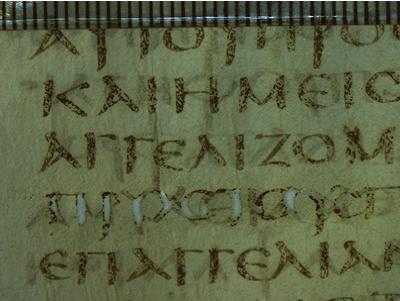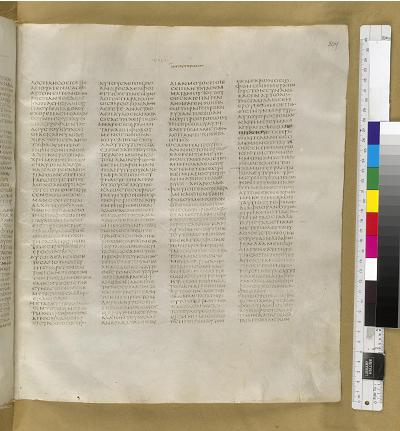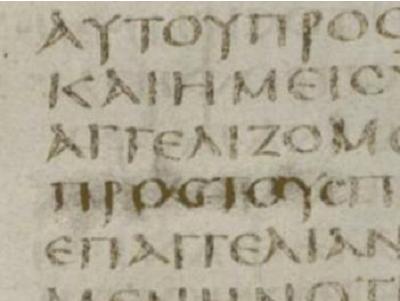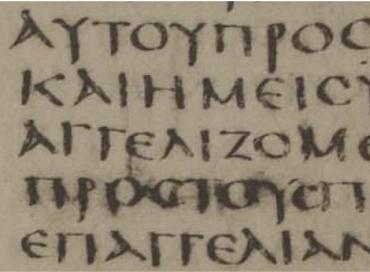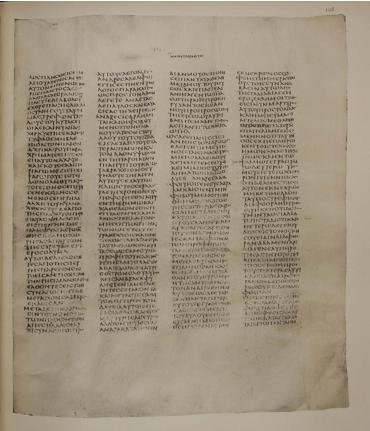


This page presents images of special points of interest found while examining the images of Codex Sinaiticus. They are images that raise questions or provide special insight regarding the origin and history of the manuscript.
Images used on this page have been obtained from the Codex Sinaiticus Project at www.codexsinaiticus.org in accordance with the non-commercial personal, and educational use provision in their copyright statement.
Images used on this page have been obtained from the Codex Sinaiticus Project at www.codexsinaiticus.org in accordance with the non-commercial personal, and educational use provision in their copyright statement.
This first set of images shows an anomaly on Q87 folio 7r (BL f:307r). The first photo is taken from the excellent report by Sara Mazzarino entitled Report on the different inks used in Codex Sinaiticus and assessment of their condition.
The questions this raises are: Why does the Codex Sinaiticus Project image look so different from the one used in Sara Mazzarino's report? Has the flaked ink (corroded area) been overwritten?
The questions this raises are: Why does the Codex Sinaiticus Project image look so different from the one used in Sara Mazzarino's report? Has the flaked ink (corroded area) been overwritten?


The answer from Sara Mazzarino is:
- "The brown is given by the background, which was chosen in order to minimize the impact of losses in the support, when looking at the images. If you compare the zoomed area [of the CSP image] with the detail pic on my report you will see that the brown areas of the first correspond to the white areas of the second. My aim was infact to highlight the loss: for that reason I chose a white background as opposed to the brown. So, yes, I can confirm there is corrosion and loss in that specific area."


This leads to a more questions:
Sara Mazzarino has provided some insight into these questions:
"I do strongly believe that the corrosion was already there [in 1911]. In fact, the area of the specific word was previously erased and corrected. This made the parchment support even thinner than it already is. For this reason the ink affected the parchment in a more severe way creating holes."
"I suspect that on KL images the holes are not clearly visible because he may have used a black background to improve contrast and legibility of the photographs. Or he may have retouched the negatives plates, again in order to improve legibility. Retouching of negatives was a very common practice and I wouldn't be surprise if this too was the case."
Sara did not note any loss of ink in comparing the 1911 Kirsopp Lake images with the actual manuscript, but comparing even the small portion in the images here it does appear that there may be significant ink loss between 1911 and 2009.
- Does the 1911 Kirsopp Lake image show ink where the report by Sara Mazzarino shows corrosion completely through the parchment and the CSP image shows the brown background paper through the corrosion?
- If so, when did the corrosion occur?
- When was the ink that caused this corrosion applied to the parchment?
Sara Mazzarino has provided some insight into these questions:
"I do strongly believe that the corrosion was already there [in 1911]. In fact, the area of the specific word was previously erased and corrected. This made the parchment support even thinner than it already is. For this reason the ink affected the parchment in a more severe way creating holes."
"I suspect that on KL images the holes are not clearly visible because he may have used a black background to improve contrast and legibility of the photographs. Or he may have retouched the negatives plates, again in order to improve legibility. Retouching of negatives was a very common practice and I wouldn't be surprise if this too was the case."
Sara did not note any loss of ink in comparing the 1911 Kirsopp Lake images with the actual manuscript, but comparing even the small portion in the images here it does appear that there may be significant ink loss between 1911 and 2009.



